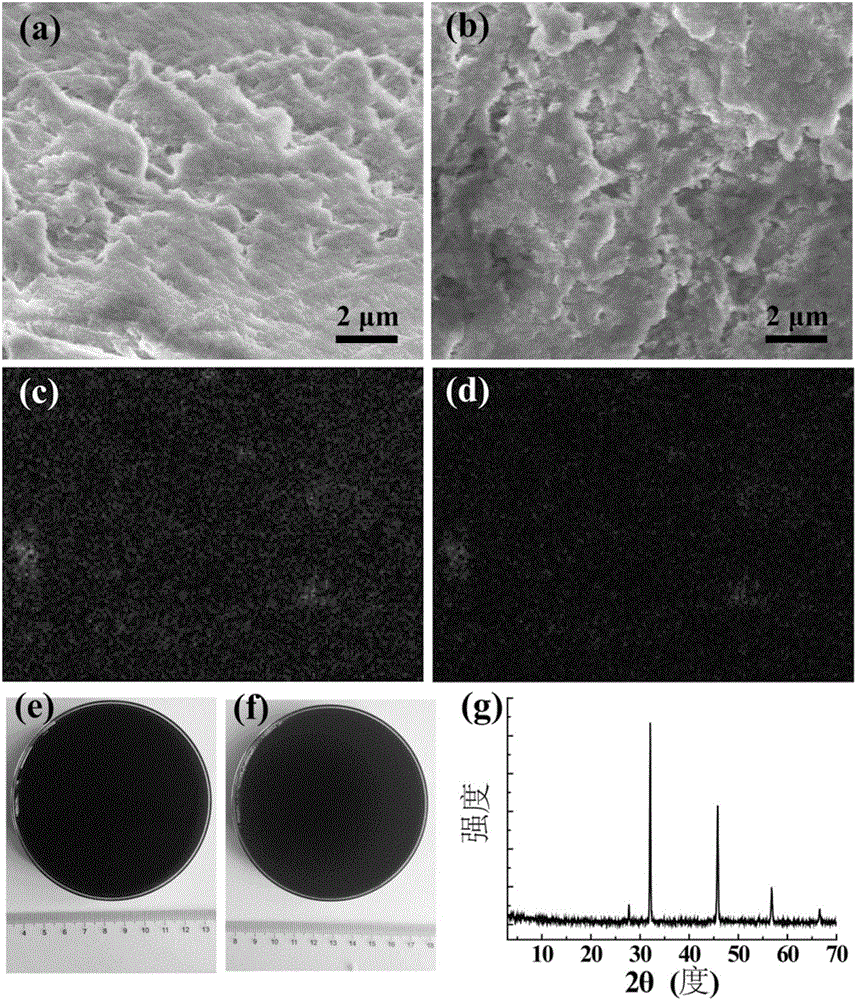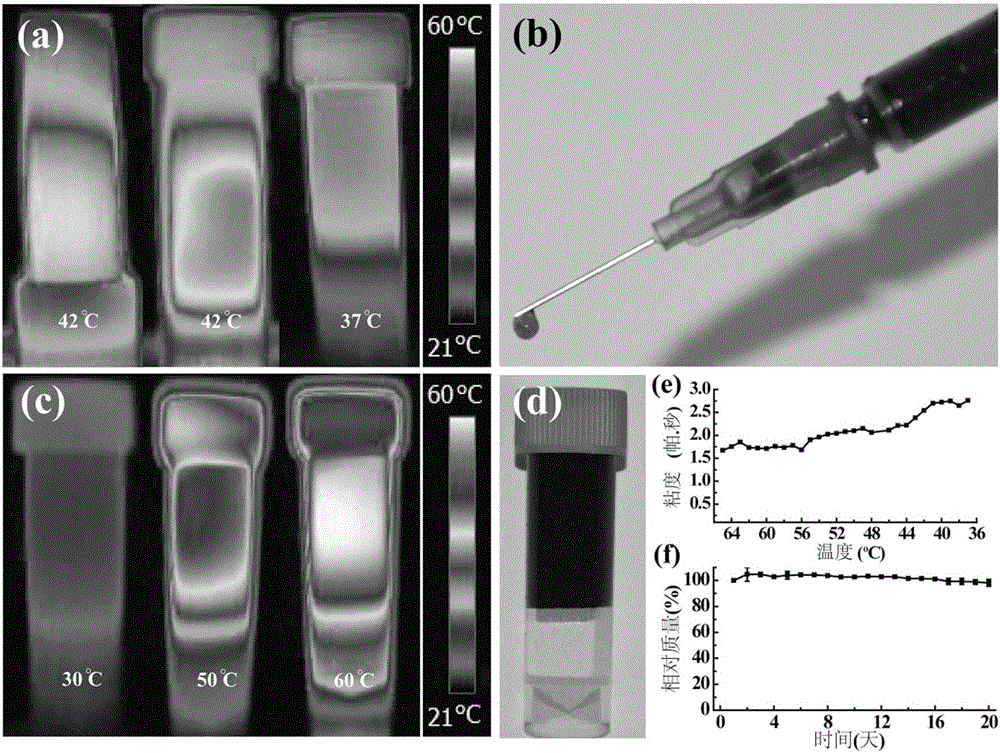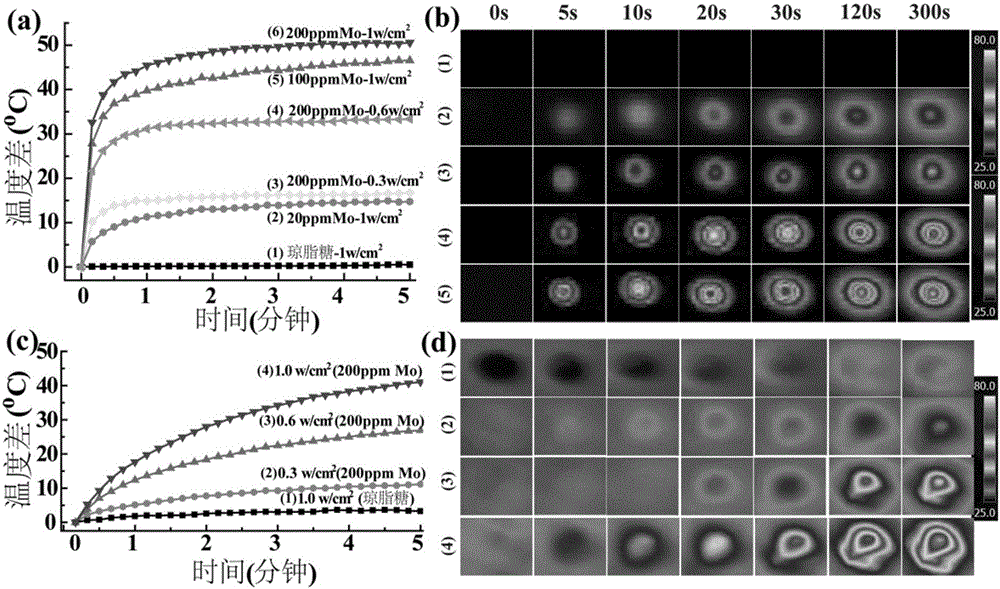Multifunctional thermosensitive agarose hydrogel and preparation method and application thereof
A kind of agarose hydrogel, multi-functional technology, applied in the direction of medical formula, medical preparations of non-active ingredients, wave energy or particle radiation treatment materials, etc., can solve the problems of uneven distribution of DOX oil sol, limited tumor treatment, etc. Achieve superior light-to-heat conversion ability, simple process, and low raw material cost
- Summary
- Abstract
- Description
- Claims
- Application Information
AI Technical Summary
Problems solved by technology
Method used
Image
Examples
Embodiment 1
[0032] Dissolve 1.5 g of agarose in 98.5 mL of deionized water, place it in a water bath at 90°C and stir for 120 minutes to obtain an aqueous solution of agarose. Then, according to the final Mo concentration of 200, 100, 50 or 20 ppm 2 / Bi 2 S 3 -PEG nanosheet dispersion (refer to Adv. Mater., 2015, 27, 2775 for the synthesis method) and 10 mg of doxorubicin hydrochloride (DOX), dissolved / dispersed in the above agarose solution, so that the concentration of Mo in the resulting AMD mixed solution The distribution is 200, 100, 50 or 20 ppm and stirring is continued for 30 minutes. After the stirring is completed, the resulting mixed solution is cooled, that is, the multifunctional agarose / photothermal material / chemotherapy drug hydrogel.
Embodiment 2
[0034] A little of the AMD hydrogel prepared in Example 1 (Mo concentration is 200ppm) was taken respectively, and the morphology and components of the hydrogel were analyzed. Field emission scanning electron microscopy and elemental analysis of its samples were performed on a FEI Magellan 400 field emission scanning electron microscope. Using Japan Rigaku D / MAX2200PC X-ray diffractometer (scanning conditions: Cu Kα rays, wavelength 1.54Å, operating voltage 40 kV, current 40 mA, scanning range: 3 o ~70 o ) to analyze the sample components.
[0035] From figure 1 (a) and (b), it can be seen that Agar-MoS 2 / Bi 2 S 3 Both PEG and AMD hydrogels have rough surfaces and their discontinuous pore structures, which lay the foundation for further cell adhesion and drug release. Element distribution scan ( figure 1 (c) and figure 1 (d)) confirms that Mo and S elements are uniformly distributed throughout the hydrogel material, from further XRD results ( figure 1 (g)) MoS can a...
Embodiment 3
[0037] Take 5mL AMD solution (Mo concentration 200ppm, solution temperature 65°C) in a 5mL cryovial, and combine with FLIR E60 thermal imaging camera to detect the fluidity and gelation process of AMD solution during the temperature change. Use SNB-1 digital viscometer to record the viscosity change of AMD solution during the temperature change. After the gelation process was completed, a certain mass of AMD hydrogel was soaked in a pH=4.0 buffer solution at 37°C, and the mass change of AMD hydrogel during 20 days of soaking was recorded.
[0038] Such as figure 2 As shown in (a), the AMD solution can still flow freely and has good injectability when it is higher than 37 °C (42 °C), and the AMD solution has not yet solidified into a gel ( figure 2 (a) left and center, figure 2 (b)); below 37 °C, the AMD mixed solution completely solidifies into a hydrogel ( figure 2 (a) right). (c–d) Strength detection of AMD hydrogels: Regardless of increasing and decreasing the tempe...
PUM
 Login to View More
Login to View More Abstract
Description
Claims
Application Information
 Login to View More
Login to View More - R&D
- Intellectual Property
- Life Sciences
- Materials
- Tech Scout
- Unparalleled Data Quality
- Higher Quality Content
- 60% Fewer Hallucinations
Browse by: Latest US Patents, China's latest patents, Technical Efficacy Thesaurus, Application Domain, Technology Topic, Popular Technical Reports.
© 2025 PatSnap. All rights reserved.Legal|Privacy policy|Modern Slavery Act Transparency Statement|Sitemap|About US| Contact US: help@patsnap.com



